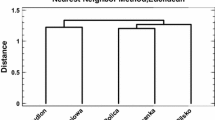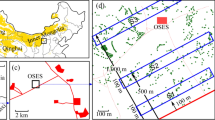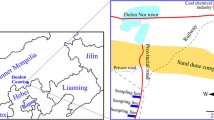Abstract
This study focused on the diversity of lichens present in selected regions of northern Tunisia and assessed their resistance to atmospheric pollution. Twenty-five species of lichen were identified, divided into 13 families and 17 different genera. The results show that the Cladoniaceae and Parmeliaceae families predominate. Foliose and complex lichens are the most abundant. The main objective of this study was to examine, via atomic absorption spectrometry, the bioaccumulation of heavy metals (lead, zinc, copper, and cadmium) in the lichens Cladonia rangiformis, Flavoparmelia caperata, Parmotrema perlatum, and Evernia prunastri, which were selected due to the presence of similar lichens at the sites. The results showed high accumulations of lead, copper, and zinc at all stations (Nefza, Babouche, Oued Zen) characterized by intense road traffic and/or industrial activity, while cadmium levels were low at all stations. Flavoparmelia caperata proved to be a species tolerant of metal stress, making it a promising candidate for air quality biomonitoring programs aimed at assessing air pollution (17.53 mg/g DW of Pb and 89.8 mg/g DW of Zn in Nefza, and 2.36 mg/g DW of Cd and 10.13 mg/g DW of Cu in Oued Zen). These results highlight the importance of lichens as biological indicators for assessing pollution, the need to carefully monitor heavy metal concentrations in urban environments, and to provide future projects with funding for their potential transplantation to polluted.











Similar content being viewed by others
Data availability
The research data associated with this article is available.
References
Abas A, Din L (2020) Diversity, composition and distribution of lichens along elevational gradients in the tropical mountain forest of Gunung Nuang, Selangor Malaysia. Eco Mont (J Prot Mountain Areas Res) 13(1):4–11. https://doi.org/10.1553/eco.mont-13-1s4
Abas A, Aiyub K, Awang A (2022) Biomonitoring potentially toxic elements (PTEs) using lichen transplant Usnea misaminensis: a case study from Malaysia. Sustainability 14(12):7254. https://doi.org/10.3390/su14127254
Adjiri F, Ramdani M, Lograda T, Chalard P (2018) Bio-monitoring of metal trace elements by epiphytic lichen in the Bordj Bou Arreridj area East of Algeria. Der PharmaChemica 10(3):1–8
Anderson J, Lévesque N, Caron F, Beckett P, Spiers GA (2022) A review on the use of lichens as a biomonitoring tool for environmental radioactivity. J Environ Radioact 243:106797. https://doi.org/10.1016/j.jenvrad.2021.106797
Asgari Lajayer B, Khadem Moghadam N, Maghsoodi MR, Ghorbanpour M, Kariman K (2019) Phytoextraction of heavy metals from contaminated soil, water and atmosphere using ornamental plants: mechanisms and efficiency improvement strategies. Environ Sci Pollut Res 26(9):8468–8484. https://doi.org/10.1007/s11356-019-04241-y
Asta J, Van Haluwyn C, Bertrand M (2016) Guide des lichens de France: Lichens des roches. Belin, Paris, pp 1–235
Azimi-Yancheshmeh R, Moeinaddini M, Feiznia S, Riyahi-Bakhtiari A, Savabieasfahani M, van Hullebusch ED, Asgari Lajayer B (2021) Seasonal and spatial variations in atmospheric PM25-bound PAHs in Karaj city, Iran: sources, distributions, and health risks. Sustain Cities Soc 72:103020. https://doi.org/10.1016/j.scs.2021.103020
Benítez Á, Medina J, Vásquez C, Loaiza T, Luzuriaga Y, Calva J (2019) Lichens and bromeliads as bioindicators of heavy metal deposition in ecuador. Diversity 11(2):28. https://doi.org/10.3390/d11020028
Boustie J, Grube M (2005) Lichens—a promising source of bioactive secondary metabolites. Plant Genet Resour 3(2):273–287. https://doi.org/10.1079/PGR200572
Chahloul N, Khadhri A, Vannini A, Mendili M, Raies A, Loppi S (2022) Bioaccumulation of potentially toxic elements in some lichen species from two remote sites of Tunisia. Biologia. https://doi.org/10.1007/s11756-022-01069-9
Chahloul N, Khadhri A, Vannini A, Mendili M, Raies A, Loppi S (2023) Selecting the species to be used in lichen transplant surveys of air pollution in Tunisia. Environ Monit Assess 195(5):570. https://doi.org/10.1007/s10661-023-11219-4
Déruelle S, Lallemant R (1983) Les lichens témoins de la pollution. Vuibert, Paris
El Mokni R, Mahmoudi MR, El Aouni MH (2010) Aperçu sur les lichens Corticoluss fruticose dans la région de Kroumiria. Révue FSB 8:72–76
El Mokni R, Jouili El-Mokni H, El-Aouni M-H (2011) Les espèces du genre Lobaria (Schreb.) Hoffm. de la région de Kroumirie (Nord-Ouest de la Tunisie): caracterisation morpho-chimique bioindication. Révue FSB 9:114–119
Fiore-Donno A-M (1997) Les lichens épiphytes comme bioindicateurs de la pollution atmosphérique genevoise. Saussurea 28:189–218
Fry KL, Gillings MM, Isley CF, Gunkel-Grillon P, Taylor MP (2021) Trace element contamination of soil and dust by a New Caledonian ferronickel smelter: dispersal, enrichment, and human health risk. Environ Pollut 288:117593. https://doi.org/10.1016/j.envpol.2021.117593
Gavériaux J-P (1999) Lichens et qualité de l’air (initiation). pp 1–10. https://www.afllichenologie.fr/telecharger/Doc/Lichens-et-qualite-Air.pdf
Grimm M, Grube M, Schiefelbein U, Zühlke D, Bernhardt J, Riedel K (2021) The lichens’ microbiota, still a mystery? Front Microbiol. https://doi.org/10.3389/fmicb.2021.623839
Van Haluwyn C, Asta J (2013) Guide des lichens de France: Lichens des arbres. Belin, Paris, pp 1–378
Van Haluwyn C, Garrec JP (2002) Biosurveillance végétale de la qualité de l’air. p117
Van Haluwyn C, Asta J, Boissière J (2014) Guide des lichens de France: Lichens des sols. Humensis, Paris, pp 1–221
Kavusi E, Shahi Khalaf Ansar B, Ebrahimi S, Sharma R, Ghoreishi SS, Nobaharan K, Abdoli S, Dehghanian Z, Asgari Lajayer B, Senapathi V, Price GW, Astatkie T (2023) Critical review on phytoremediation of polyfluoroalkyl substances from environmental matrices: need for global concern. Environ Res 217:1144. https://doi.org/10.1016/j.envres.2022.114844
Khadhri A, Mendili M, Araújo MEM, Seaward MRD (2019) Comparative study of secondary metabolites and bioactive properties of the lichen Cladonia foliacea with and without the lichenicolous fungus Heterocephalacria bachmannii. Symbiosis. https://doi.org/10.1007/s13199-019-00630-6
Lawal O, Ogugbue CJ, Imam TS (2023) Mining association rules between lichens and air quality to support urban air quality monitoring in Nigeria. Heliyon 9(1):e13073. https://doi.org/10.1016/j.heliyon.2023.e13073
Llop E, Pinho P, Matos P, Pereira MJ, Branquinho C (2012) The use of lichen functional groups as indicators of air quality in a Mediterranean urban environment. Ecol Ind 13(1):215–221. https://doi.org/10.1016/j.ecolind.2011.06.005
Lorenz C, Bianchi E, Poggiali G, Alemanno G, Benesperi R, Brucato JR, Garland S, Helbert J, Loppi S, Lorek A, Maturilli A, Papini A, de Vera J-P, Baqué M (2023) Survivability of the lichen Xanthoria parietina in simulated Martian environmental conditions. Sci Rep 13(1):4893. https://doi.org/10.1038/s41598-023-32008-6
Mendili M, Bannour M, Araújo MEM, Aschi-Smiti S, Mark RDS, Khadhria A (2019) Secondary metabolites and antioxidant capacity of the Tunisian lichen Diploschistes ocellatus (Ascomycota). Int Med Mushrooms. https://doi.org/10.1615/IntJMedMushrooms.2019031423
Mendili M, Bannour M, Araújo MEM, Seaward MRD, Khadhri A (2021a) Lichenochemical screening and antioxidant capacity of four Tunisian lichen species. Chem Biodivers. https://doi.org/10.1002/cbdv.202000735
Mendili M, Essghaier B, Seaward MRD, Khadhri A (2021b) In vitro evaluation of lysozyme activity and antimicrobial effect of extracts from four Tunisian lichens: Diploschistes ocellatus, Flavoparmelia caperata, Squamarina cartilaginea and Xanthoria parietina. Arch Microbiol 203(4):1461–1469. https://doi.org/10.1007/s00203-020-02129-x
Mendili M, Seaward MRD, Khadhri A (2022a) Does the lichenicolous fungus Heterocephalacria bachmannii affect the antimicrobial potential of its host Cladonia foliacea? Nat Prod Res 36(12):3095–3099. https://doi.org/10.1080/14786419.2021.1933974
Mendili M, Khadhri A, Mediouni-Ben Jemâa J, Andolfi A, Tufano I, Aschi-Smiti S, DellaGreca M (2022b) Anti-inflammatory potential of compounds isolated from Tunisian lichens species. Chem Biodivers. https://doi.org/10.1002/cbdv.202200134
Seed L, Wolseley P, Gosling L, Davies L, Power SA (2013) Modelling relationships between lichen bioindicators, air quality and climate on a national scale: results from the UK OPAL air survey. Environ Pollut 182:437–447. https://doi.org/10.1016/j.envpol.2013.07.045
Sérusiaux E, Diederich P, Lambinon J (2004) Les macrolichens de Belgique, du Luxembourg et du nord de la France. Ferrantia 40–188
Shahi Khalaf Ansar B, Kavusi E, Dehghanian Z, Pandey J, Asgari Lajayer B, Price GW, Astatkie T (2022) Removal of organic and inorganic contaminants from the air, soil, and water by algae. Environ Sci Pollut Res. https://doi.org/10.1007/s11356-022-21283-x
Sharma M, Mohammad A (2020) Lichens and lichenology. In: Yusuf M (ed) Lichen-derived products: extraction and applications. Wiley, Hoboken, pp 101–118
Soleimany A, Grubliauskas R, Šerevičienė V (2021) Application of satellite data and GIS services for studying air pollutants in Lithuania (case study: Kaunas city). Air Qual Atmos Health 14:411–429. https://doi.org/10.1007/s11869-020-00946-z
Sujetoviene G, Sliumpaite I (2013) Response of Evernia prunastri transplanted to an urban area in central Lithuania. Atmos Pollut Res 4(2):222–228. https://doi.org/10.5094/APR.2013.023
Syed Salleh SNA, Abas A (2023) Monitoring heavy metal concentrations using transplanted lichen in a tourism city of Malaysia. Sustainability 15(7):5885. https://doi.org/10.3390/su15075885
Tiévant P (2001) Guide des lichens. Delachaux, Colombes, p 304. ISBN: 9782603012116
Van Herk CM (2001) Bark pH and susceptibility to toxic air pollutants as independent causes of changes in epiphytic lichen composition in space and time. Lichenologist 33(5):419–442. https://doi.org/10.1006/lich.2001.0337
Van Haluwyn C, Lerond M (1986) Les lichens et la qualité de l’air, évolution méthodologique et limites. Ministère de l’Environnement, Paris, p 207
Zahra F, Alami O, Ouali Alami FZ, Elabidi A, Mouhir L, Fekhaoui M, & Serghini A (2014) Utilisation des lichens comme bio-indicateurs de la pollution atmosphérique par le plomb, cadmium et zinc de la région de Rabat-Sale-Zemmour-Zaêr (Maroc). Afrique Sci 10(3). http://www.afriquescience.info.
Author information
Authors and Affiliations
Corresponding author
Additional information
Responsible Editor: Giulia Guerriero.
Rights and permissions
Springer Nature or its licensor (e.g. a society or other partner) holds exclusive rights to this article under a publishing agreement with the author(s) or other rightsholder(s); author self-archiving of the accepted manuscript version of this article is solely governed by the terms of such publishing agreement and applicable law.
About this article
Cite this article
Mendili, M., Jrad, T.B. & Khadhri, A. Lichen diversity and bioaccumulation of heavy metals in northern Tunisia: a study to evaluate environmental pollution. Euro-Mediterr J Environ Integr 8, 847–862 (2023). https://doi.org/10.1007/s41207-023-00413-y
Received:
Accepted:
Published:
Issue Date:
DOI: https://doi.org/10.1007/s41207-023-00413-y




